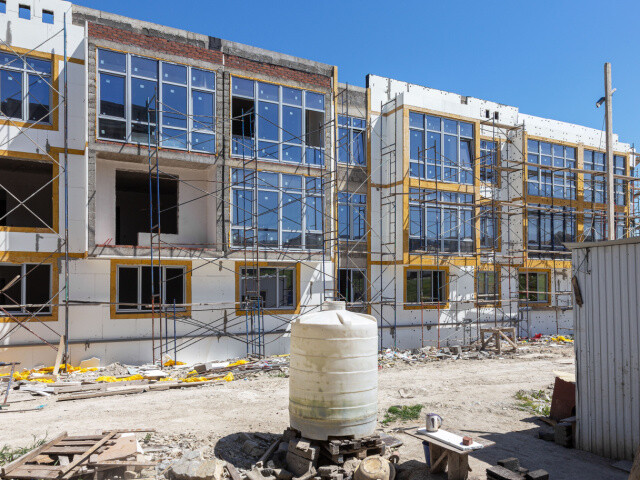Mar 30, 2023 - 3-5 minutes
Why You Need SMP Liquid Flashing in Your Commercial Construction

Find out why you should consider liquid flashing and how the right technology for it gives builders the durability they need.
In the commercial construction industry, builders rely on manufacturers to provide window, door and building envelope coating sealants that protect steel and wood framing against air and moisture leakage. This protection enables energy efficiency, durability and healthy indoor environments with minimal utility, maintenance or repair costs. However, finding the right sealant solution that enforces a tight building envelope can be challenging.
Fortunately, liquid flashing makes it easy for manufacturers to provide the necessary protection. Find out why you should consider liquid flashing and how the right technology for it gives builders the durability they need.
Fortunately, liquid flashing makes it easy for manufacturers to provide the necessary protection. Find out why you should consider liquid flashing and how the right technology for it gives builders the durability they need.
How Liquid Flashing Improves Commercial Buildings
Compared to other options, liquid flashing can shift with structural movement over time, creating long-lasting durability that also enables energy efficiency and healthy indoor environments. Liquid flashing enables these capabilities by offering:
- Air leakage protection: Liquid flashing can help the entire system control airflow, heat and other radiations from going through the layers of building envelope. This decreases air leakage and improves energy efficiency, which reduces expenses for building owners.
- Vapor permeability: If there is no way for the building envelope to dry out, any airflow that carries moisture can greatly impact long-term performance of other materials such as air vents and foundation. Liquid flashing can seal to both dry and damp surfaces, allowing the water vapor to move through its membrane. This creates smooth water tightness in rough openings and seams, enabling a window or door to dry out both inside and outside. Vapor permeability of liquid flashing therefore prolongs durability for the entire window or door, contributing to an efficient building envelope within the structure.
- Decreased application time: Liquid flashing does not require intricate folding methods to fit into intricate corners, saving time with easy, seamless application.
- Simplified processes: Easily applicable to uneven surfaces, corners and small crevices, liquid flashing doesn’t require multiple protective layers because it becomes part of the structure itself once it’s sealed. Liquid flashing allows builders to work fast because they can ensure one layer will seal in between any intricate areas. Additionally, liquid flashing can be applied to wet and damp substrates, allowing a builder to stay on schedule with fewer rain delays.
- Chemical compliance: Liquid flashing is VOC compliant, allowing it to be used anywhere among window, door and other protective wall boarding.
How SMP Technology Enhances Liquid Flashing Capabilities
As a hybrid technology, silyl modified polymer (SMP) products combine the benefits of both polyurethane and silicone technologies to form a moisture-curing sealant product that is ideal for commercial liquid flashing. When liquid flashing is based on SMP technology, it offers additional advantages, such as:
- Primerless adhesion to building materials: SMP technology can bond to substrates such as wood, concrete, metals and glass without the first step of applying a primer. Additionally, as a one-component solution, no mixing is required, which helps streamline processes and decrease error likelihood.
- Strong weatherability and UV resistance: Due to their high solids content, SMP products will not shrink over time. Since the liquid flashing will seal on to the structure, it will also protect a building as it shifts over time from various weather temperatures and conditions. Further, because it is formulated with light stabilizers, SMP technology can limit UV to protect against discoloration or elasticity loss. This protection is especially helpful when liquid flashing is being applied, since it may be exposed to outdoor elements for months throughout the duration of a commercial project.
- Solvent, isocyanate and PVC free formulation: SMP technology is not comprised of potentially harmful chemicals that could get released through moisture in the air. Instead, it is a low odor technology that enables healthy airflow.
How Bostik Can Help with SMP Liquid Flashing
Bostik provides a range of building envelope technologies that allow manufacturers to complete their portfolio, offering their customers high end-use performance and improved efficiencies in commercial construction applications. Our team understands manufacturers' needs to provide durable, seamless products for window, door and wall applications. In particular, our expertise and formulation testing for SMP technology ensures the liquid flashing will provide strong protection while meeting industry standards.
Ready to see how SMP liquid flashing can improve protection and durability? Contact a Bostik representative today.
Contact an Expert
Ready to see how SMP liquid flashing can improve protection and durability? Contact a Bostik representative today.
Contact an Expert
©2023 Bostik, Inc. All Rights Reserved
All information contained herein is believed to be accurate as of the date of publication, is provided “as-is” and is subject to change without notice. To review our full U.S. Legal Disclaimer, visit: https://bostik.com/us/en_US/privacy-policy/legal-disclaimer
All information contained herein is believed to be accurate as of the date of publication, is provided “as-is” and is subject to change without notice. To review our full U.S. Legal Disclaimer, visit: https://bostik.com/us/en_US/privacy-policy/legal-disclaimer
